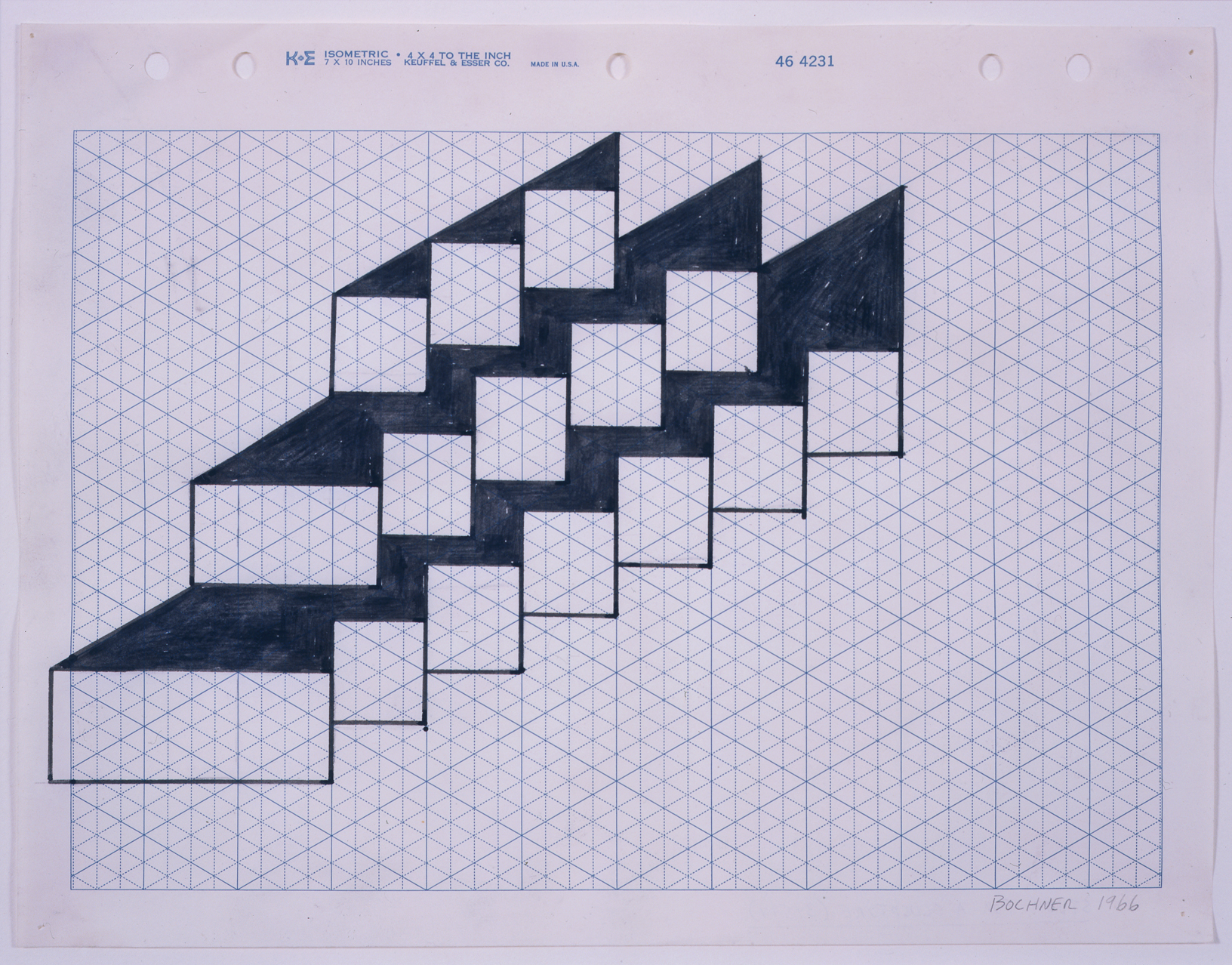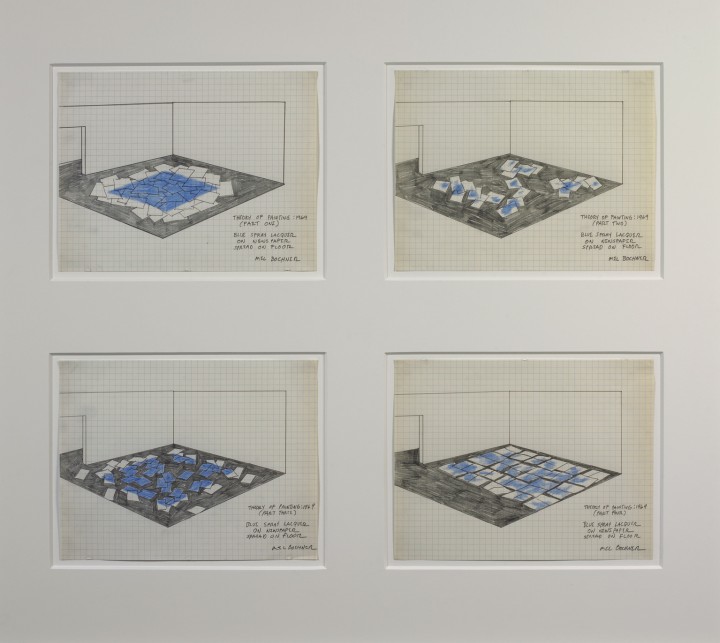
Figure 1. Mel Bochner, Study for Sculpture (3/5/7), 1966
Ink on isometric paper, 8 1/2 x 11 inches (21.6 x 27.9 cm)
© 2012 Mel Bochner
Mel Bochner
by Matthew Bailey
These two drawings by Mel Bochner are meticulously conceived studies for a sculpture and an installation. Representing just one form of the artist’s numerous bodies of works on paper they act as visual articulations of his ideas and serve as proposals with the potential for future realization. Bochner has been a prominent and influential figure in Conceptual art since its inception in the 1960s. In 1966 he organized the exhibition Working Drawings and Other Visible Things on Paper Not Necessarily Meant to Be Viewed as Art, which announced his belief in the crucial role of drawing as a speculative tool for artists. The show has often been hailed as foundational to Conceptual art because of the way he collected, photocopied, and arranged diagrammatic plans for Minimalist artworks by fellow artists rather than exhibiting the finished objects.1 Bochner regarded drawing as a medium perfectly suited to Conceptual practices because of its flexible and provisional nature, and he wrote extensively about its role in artistic practice. For Bochner, the medium offered “a directness of means with an ease of revision.”2 Drawings could function as “the site of private speculations,” providing “a snapshot of the mind at work.”3 Acting, in his words, as “the residue of thought, the place where the artist formulates, contrives, and discards his ideas,” they “frequently contain the artist’s false starts, meanderings, errors, and incorrect arithmetic, as well as possibilities which might not have occurred to him in any other language.”4
Study for Sculpture (3/5/7) (1966; fig. 1) and Theory of Painting (1–4) (1969; fig. 2) exemplify what Bochner deemed “working drawings,” meaning drawings that “have a purpose other than the merely functional.”5 Unlike traditional sketches for paintings or sculptures, such works served as a field of theoretical experimentation surrounding objects and installations. For all Bochner’s emphasis on the tentative and improvisatory nature of drawing as a site of graphic speculation, however, his drawings are firm, clear, decisive, and ordered, signifying conceptual certainty and visual clarity. This is revealed in his bold, straight lines; carefully crafted forms; attention to shading and color; and concise handwritten notations. The ordered appearance of his drawings was achieved in part through his consistent use of graph paper as a systematic guide that “permits,” as he found, “the easy, and immediate, alignment of thoughts into conventionalized patterns of reading and forming,” a way of making private, abstract meanderings publicly accessible.6 Study for Sculpture employs the structure of graph paper to illustrate an idea for a three-dimensional Minimal sculpture composed of a series of interconnected triangles, drawn with a precise delineation of contours and shading that follows the underlying geometric pattern.

Figure 2. Mel Bochner, Theory of Painting (1-4), 1969
Graphite, ink and crayon on graph paper, 4 sheets, each 8 1/2 x 10 1/2 inches (21.6 x 26.7 cm)
© 2012 Mel Bochner
Works such as Study for Sculpture make apparent the gap between drawing as a two-dimensional space of conceptual speculation and the concrete, three-dimensional artworks that drawings represent, which often remain unrealized. Through his graphic studies, Bochner has frequently examined the parameters and characteristics that define and constitute works of art. This is especially true of Theory of Painting, part of a series of works produced in the 1970s that demonstrate his prolonged investigation of the conventions, languages, and limitations of the medium of painting, in what he called “an analytical attempt to rethink painting’s functions and meanings.”7 The carefully executed study on gridded paper shows four components of a large-scale installation, the materials for which are described in the artist’s notation: “Blue spray lacquer on newspaper spread on floor.” In the first configuration, a blue square is painted on sheets of newspaper clustered on the floor; in the second, the newspapers have been haphazardly scattered, obliterating the square; in the third, the form of a blue square is regained in papers carefully dispersed across the floor; and in the fourth, the papers have been arranged into a rectangular grid, again dissolving the blue square. Playing off Jackson Pollock’s famous drip paintings executed on the ground, Bochner’s work investigates painting as a language of artificial, reproducible, and rearrangeable signs, like the newsprint that acts as the painting’s support. Although the installation depicted has been realized, the sketched plan raises the additional question of whether painting is defined by its physical characteristics, its conceptual aspects, or its spatial locations, with the drawing serving as yet another language through which painting can be materialized and theorized.
Notes
1. The exhibition was at the Visual Arts Gallery, School of Visual Arts, New York. See James Meyer, “The Second Degree: Working Drawings and Other Visible Things on Paper Not Necessarily Meant to Be Viewed as Art,” in Mel Bochner: Thought Made Visible, 1966–1973, ed. Leslie K. Baier (New Haven, CT: Yale University Art Gallery, 1995), 94–106.
2. Mel Bochner, “Drawing” (1981), in Solar Systems and Rest Rooms: Writings and Interviews, 1965–2007 (Cambridge, MA: MIT Press, 2008), 131.
3. Bochner, “Working Drawings and Other Visible Things on Paper Not Necessarily Meant to Be Viewed As Art” (1977), ibid., 177.
4. Bochner, “Anyone Can Learn to Draw” (1969), ibid., 61.
5. Ibid.
6. Ibid.
7. Bochner, in “How Can You Defend Making Paintings Now: A Conversation between Mel Bochner and James Meyer,” in As Painting: Division and Displacement, ed. Philip Armstrong, Laura Lisbon, and Stephen Melville (Columbus, OH: Wexner Center for the Arts; Cambridge, MA: MIT Press, 2001), 199.
Bios
Matthew Bailey
Mel Bochner
